HONOne page per dayA6A5
- Japanese
- English
- One Piece
- Can be used on its own without a cover
- The page-per-day format allows you to keep daily records freely
- Choose your favorite from a variety of cover designs
Summary

- The Hobonichi Techo HON with a book-like design is a compact, page-per-day type techo with a hardcover design already attached to the book. They come in A6 and A5 sizes. The format and contents are the same as the Original and Cousin. You can also choose from a wide variety of cover designs.
- Can be used on its own without a cover

- The page-per-day format allows you to keep daily records freely

- Choose your favorite from a variety of cover designs

Specifications
 Cover and Basic Features
Cover and Basic Features

Book cover
This is a techo with a hardcover design already attached to the book, and you can choose from a variety of cover designs. Because it’s compact and easy to carry around, it's a Hobonichi Techo you can keep in your bag and take with you everywhere.

Choose from two sizes (A6 / A5)
The HON comes in two sizes: A6 and A5. The A6 is compact and convenient for carrying around. The A5 is twice the size of the A6, ideal for those who want plenty of space to write.

Perfect planner paper
The book uses thin, light yet durable Tomoe River paper. This paper that underwent an overhaul with the 2024 edition techo is more resistant to bleed through, lighter despite being the same thickness, and has a smoother surface by adjusting the fibers of the paper. It’s a new, specially crafted paper for the techo.

180-degree lay-flat binding
Special stitch-binding allows the planner to lay completely flat without having to hold it down.

Endpaper special to the HON
The endpaper is unique to the HON and is designed with the letters “HON.”

2025
The book spine has the year 2025 for easy reference when placed in your bookshelf alongside other books.

Two bookmarks
The HON includes two bookmarks you can use to hold your place in commonly-used pages.
(Paper Series: Black Gingham does not come with bookmarks)

Rounded corners
The page corners are rounded to minimize creasing and damage to the edges when carried around or stored in a bag.

Serial number
Serial numbers on the inside back cover give each planner a unique identity and make your planner your very own special book.
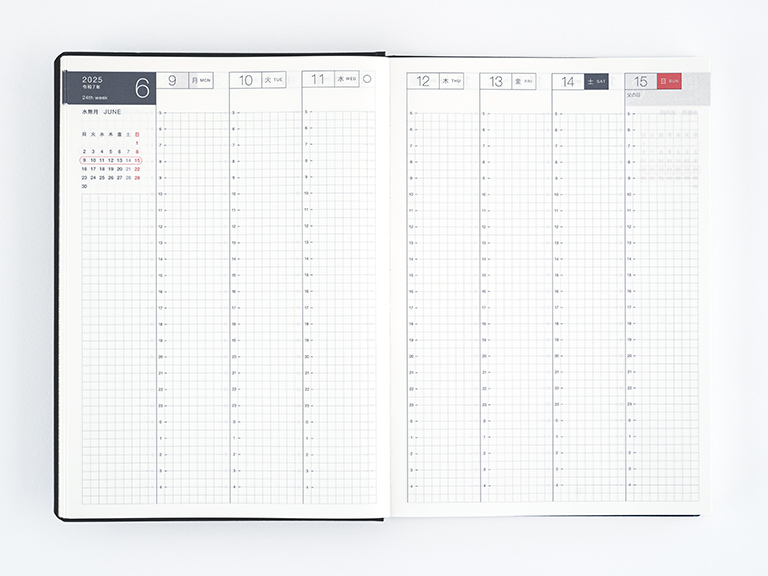
Weekly pages exclusive to the A5 size
The HON A5 size includes weekly pages which track a week in each two-page spread for easy planning and contain a handy time schedule.
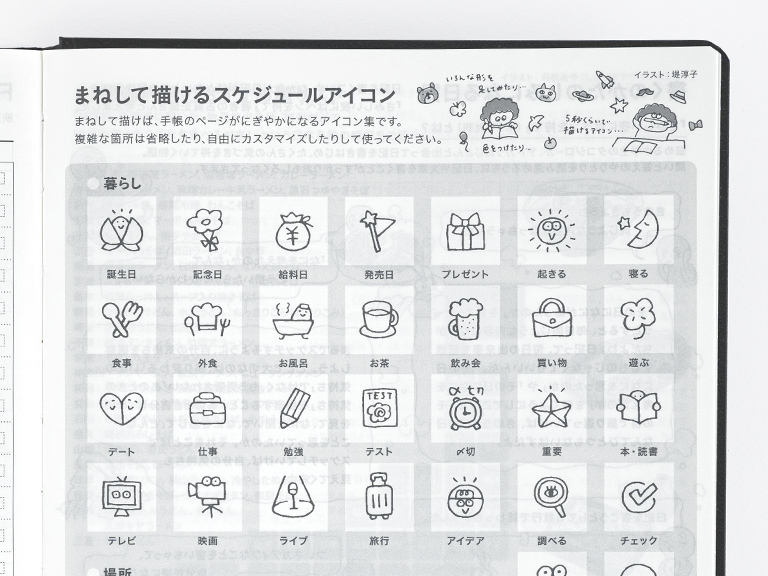
New in 2025
The bonus pages have been updated.
New for the 2025 Edition:
- Sample Symbols and Icons
- How to Have Fun Keeping a Diary
- Recommended Noodle List of 47 Prefectures
Removed from the 2025 Edition:
- An Interview with Myself
- Seasonal Sweets to Make at Home
- Caring for Your Eyes
*National holidays are subject to change due to law revisions.
 Yearly Calendar / Yearly Index
Yearly Calendar / Yearly Index
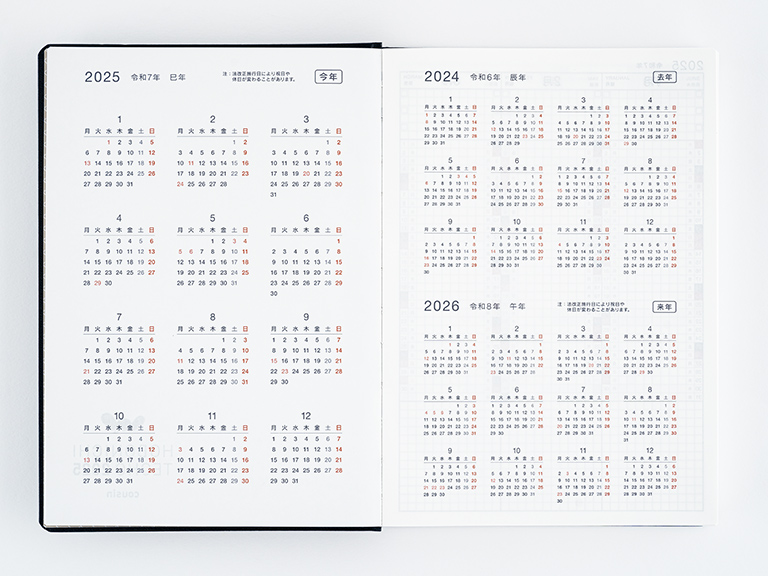
Yearly calendar
A convenient double-page spread shows the yearly calendars for 2024, 2025 and 2026 at one glance as a useful reference when planning ahead.
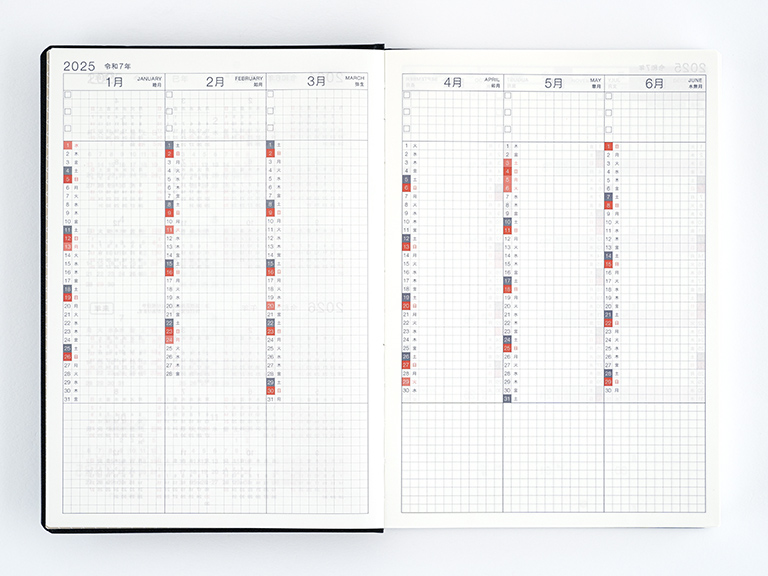
Yearly index
This page is for managing schedules in the long-term with 4 months per spread on the A6 size and 6 months per spread on the A5 size. For the A5 size, the top of each monthly column includes checkboxes for writing goals and to-do lists, and the bottom of the page has extra space for note-taking.
Yearly index coverage:
- A6 size
December 2024 to March 2026
- A5 size
January 2025 to Decamber 2025
 Monthly Calendar
Monthly Calendar

Monthly calendar
The monthly calendar is ideal for managing schedules. The graph paper design is lightly printed to make it easier to write in your plans and take notes in an even line. The blue gray and red print both allow for high visibility when writing in the calendar.
[About the English edition HON]
The English edition is not listed with national holidays.

Monthly data
Each header includes the year, numerical month, the traditional Japanese name of the month, and the English name of the month.
[About the English edition HON]
The English edition does not list the traditional Japanese name of the month.
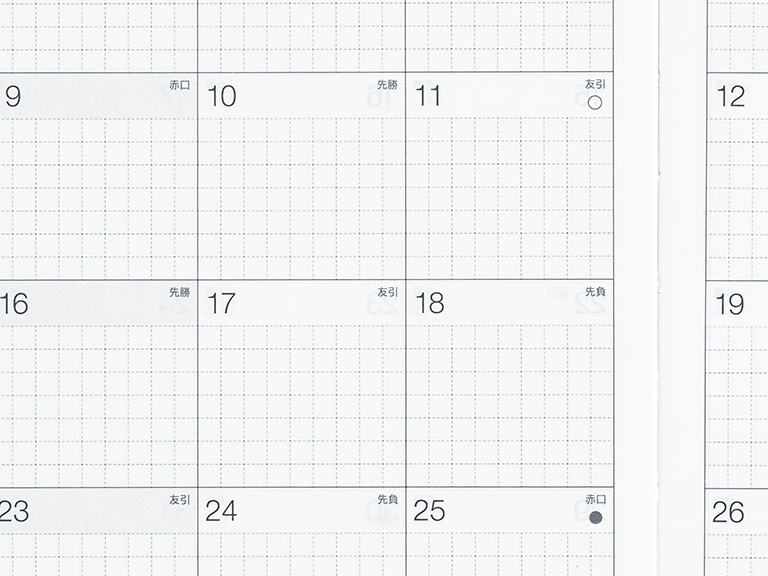
Daily boxes
Each box is lightly printed with a graph design to make it easy to fill in a full day’s worth of plans. You can also take full advantage of the graph design by drawing out sections to allocate plans or entries visually.
[About the English edition HON]
The English edition does not list holidays.
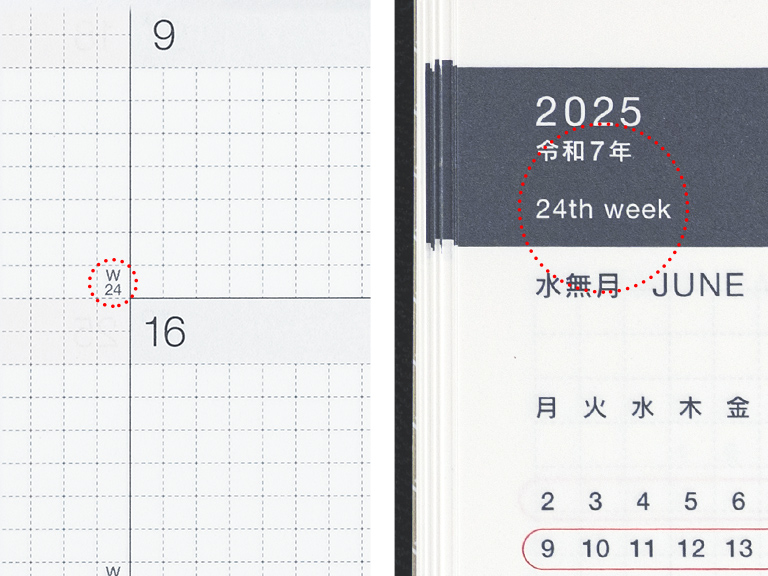
Week number
The monthly calendars include the number of the week. The formula we use begins counting with the first week in January that includes a Thursday.
[About the English edition HON]
The English edition is not listed with Rokuyo (traditional Japanese lunisolar calendar).
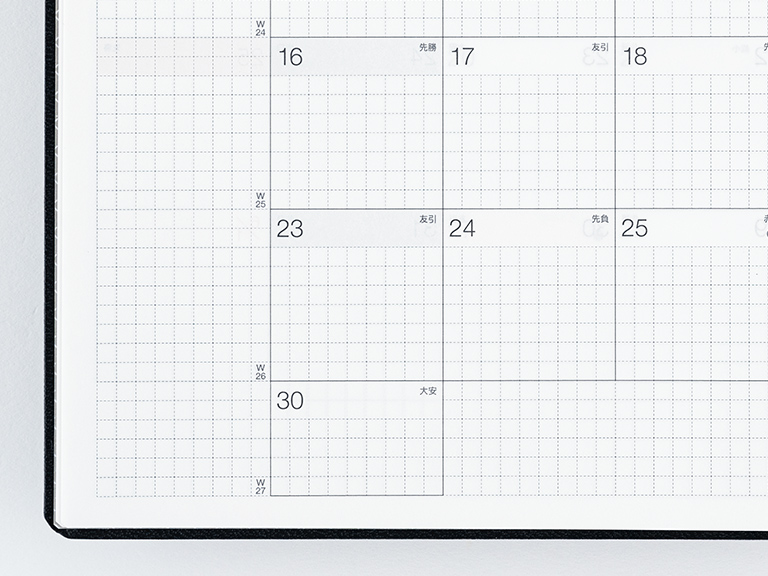
Free space
The calendars include free space below and to the left for taking notes, making plans or decorating the calendars with stickers and washi tape.
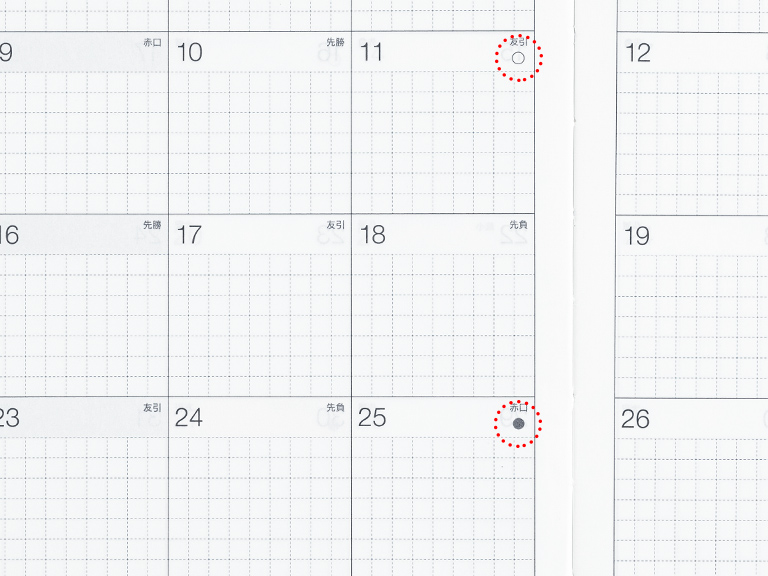
Moon phase
The calendars include icons depicting new moons (●) and full moons (○). (While the moon phase is the same across the world, the exact dates the moon phases land on are listed in Japan time.)

Rokuyo (Traditional Japanese calendar)
The monthly calendar days are labeled with rokuyo, a cycle of six days said to predict good or bad fortune that day. The labels are commonly found on Japanese calendars and used to plan weddings and funerals.
[About the English edition HON]
The English edition does not list the Rokuyo.
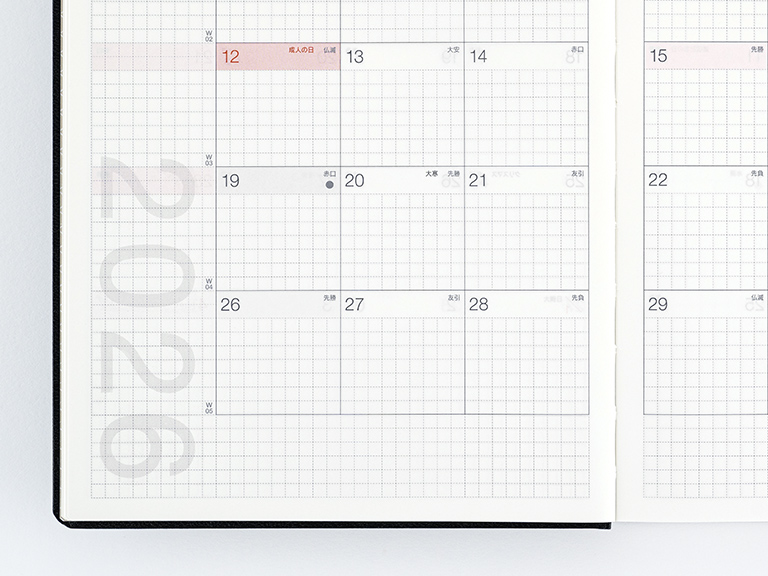
Labeling 2026
The pages for 2026 have the year in large numbers in the background to easily differentiate them from the 2025 pages.
 Weekly pages (A5 size only)
Weekly pages (A5 size only)

Weekly pages
The A5 size HON contains weekly calendars that are useful for managing detailed schedules for the week. The timeline covers a full day from 5 AM to 4 AM the following day, allowing users to record any and all plans.

Monthly data
Each header includes the numerical month, the year, the traditional Japanese name of the month, and the English name of the month. The calendar also includes the number of the week.
[About the English edition HON]
The English edition does not list the traditional Japanese name of the month.

Calendar and free space
The weekly page includes a mini monthly calendar at the top left of every two-page spread. Underneath it is free space for taking notes, making plans or decorating the calendars with stickers and washi tape.

Moon phase
The calendars include icons depicting new moons (●) and full moons (○). (While the moon phase is the same across the world, the exact dates the moon phases land on are listed in Japan time.)

Time line
The weekly calendar contains a time line that begins at 5 AM and ends at 4 AM the next day. Each hour consists of two lines on the grid, making it easy to write in intervals of 30 minutes.
 Daily Pages
Daily Pages

One day per page
The planner features a format with a page devoted to each day. There’s lots of open space to plan the day ahead and enjoy recording your memories and activities. Think of the pages as containers for random ideas, with a clear record of the date. Paste magazine clippings, ticket stubs and photos to make the techo something completely unique ― your imagination is the only limit.
*The image shows the A5 size

Moon phase and day of the year
An illustration of the current moon phase is paired with the day of the year. The new moon (●) and full moon (○) symbols are surrounded by stars at their peak. (While the moon phase is the same across the world, the exact dates the moon phases land on are listed in Japan time.)

Old Japanese lunisolar calendar
The date of the old Japanese lunisolar calendar is also included under the day’s date. This calendar was used in Japan until 1873, when Japan adopted the universal Gregorian calendar. Some days in this lunisolar calendar are specified as standard days signifying the changing of the seasons. We’ve also included solar terms based on this ancient calendar.
[About the English edition HON]
The English edition does not list the old Japanese lunisolar calendar and solar terms.

To-do list
The to-do list is located at the top of the page with checkboxes for keeping track of your goals for the day.

24-hour timetable
Work and personal plans take place at different times of the day, so the planner uses a full 24-hour timetable to accommodate all schedules. Each hour is labeled with a dot, and every 30-minute mark is labeled with a line.

The “Secret Line”
There’s also something we call the “Secret Line”: a vertical line that runs parallel along the right of the timetable. This separates the schedule on the left from the open memo pad on the right. We’ve printed it lightly enough that you can ignore it when using the page as a whole.

3.7 millimeter graph paper
The 3.7 millimeter graph paper was the result of extensive tests for an ideal size for writing in Japanese, although the size also allows comfortable writing in any language. Feel free to write along the lines of a single line or two ― or just ignore the lines altogether.

Japanese holidays
Japanese holidays are printed in a light ink to make it easy to write over them.
[About the English edition HON]
The English edition does not list holidays.
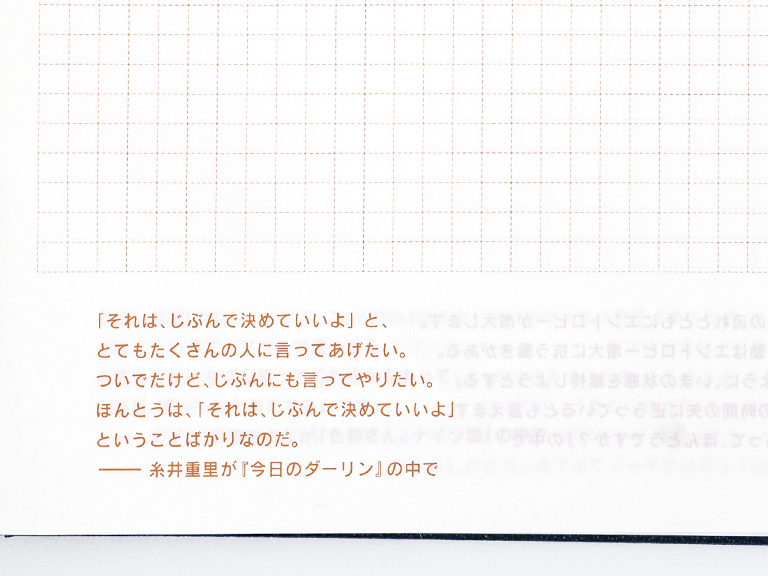
Daily quote
Since its launch in 1998, the website "Hobo Nikkan Itoi Shinbun" has been updated daily. From various interviews, columns, reader submissions, and Hobonichi School content featured on the site, we’ve thoughtfully selected words that bring joy and delight. These chosen words are displayed at the bottom of each page, one per day.
[About the English edition HON]
Each spread of the techo features a quote specially selected from the planner’s parent site, Hobo Nikkan Itoi Shinbun.

12-color tab
Similar to a dictionary, each month is labeled with a different colored tab on the edge of the page for easy reference, even when the book is closed. It is easy to flip ahead to write future plans, or flip back to read old pages.

Mini calendar
The daily page also includes a mini monthly calendar at the bottom right of every two-page spread. The dates of the current pages are outlined.

Turning the page
This warming-up page helps you get ready for the new year. It’s a great place to write your reflections on the past year, list your goals for the year ahead, copy down important information from last year’s planner, or do anything else you need to feel prepared.
The left and right corners of the page contain calendars for the two months surrounding the book’s initial start date.
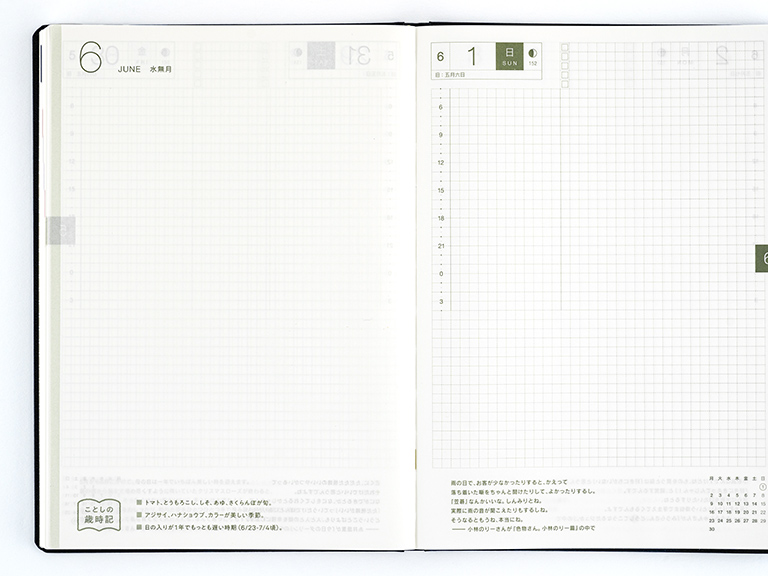
Remember This
We’ve included a page at the beginning of each month for note-taking. It includes a seasonal compendium for everyday life with information such as foods that are in season and season-specific events for modern-day life.
[About the English edition HON]
The English edition does not include the seasonal compendium.
 Bonus Pages
Bonus Pages

Memo pages
These pages are made with the same 3.7 millimeter graph paper design used in the daily pages.
Number of memo pages:
A6 size: 15 pages
A5 size: 6 pages

Time Table
The book includes two timetables for recording recurring schedules by day of the week. They’re useful for organizing activity schedules, dividing household chores, and more.

Graph Paper
The graph paper is convenient for recording your daily weight or other changes when you have a certain target in mind. The horizontal X-axis along the bottom contains 31 boxes to easily cover a one-month span, with extra space at the bottom for additional notes.

Favorites
The Favorites page is a great place to list rankings for movies, books, music, restaurants, plays, games and much more — on a sliding scale of 5 stars.

My 100
You can use this 100-item list to make a list for anything you want: things to accomplish this year, books you’ve read, movies you’ve seen, snacks you’ve tried, shops you want to visit — it’s up to you!

Sample Symbols and Icons
This section has a collection of 55 icons for you to copy and use to brighten up your techo. Adapt them, simplify them, color them, add to them — use them any which way you like!
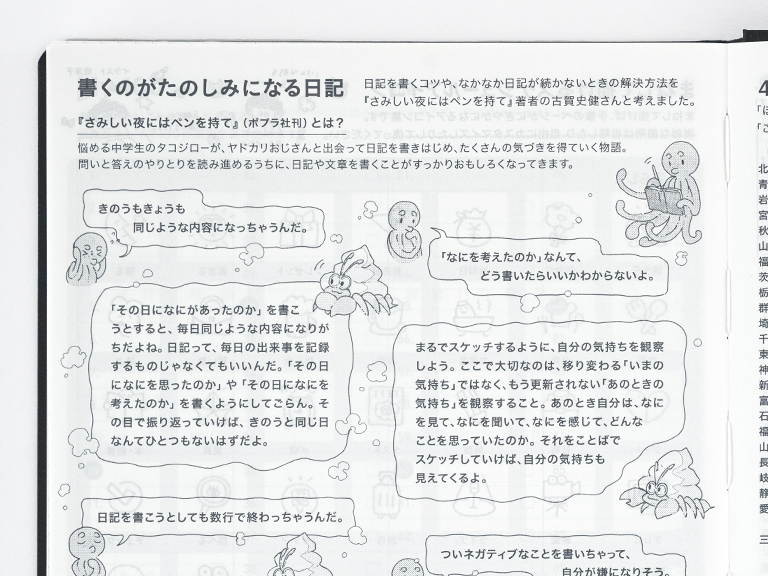
How to Have Fun Keeping a Diary
With the help of Fumitake Koga, we’ve come up with some hints to help you write and keep writing in your diary.

Recommended Noodle List of 47 Prefectures
We asked Hobonichi users to share their top noodle recommendations from their hometowns or places they’ve visited.
About the English edition HON:
The English edition includes a bonus page titled “Oodles of Noodles” that introduces the standard noodle types in Japan, such as soba and ramen, and lists recommended servings for each.

Solar Terms (Japanese)
This section explains the names and origins of solar terms that make up the 24 points in traditional East Asian lunisolar calendars. These include well-known days such as the start of spring and the winter solstice.
About the English edition HON:
This page is not included in the English edition book.

Emergency Preparedness (Japanese)
This page contains a checklist of items to have ready in case of an emergency. There is also a space to list nearby evacuation zones (common in Japan), emergency contact information and topics discussed between family and friends.
About the English edition HON:
This page is not included in the English edition book.

Words to Remember
About the English edition HON:
This page is exclusive to the English edition. You can write down phrases and words you encountered throughout the year that you want to read back on or avoid forgetting. Use the shaded area to write down dates or citations.

365 Days Check-Off Sheet
About the English edition HON:
This page is exclusive to the English edition. This page has a bubble you can fill in for each day of the year. Use it to track studying, working out at home, or anything else you’d like to do every day. Let this check-off sheet help you stay motivated and achieve your goals!

Looking Back at the Year 2025
About the English edition HON A6 size:
This bonus page is only included in the English edition A6 size HON. Use this page to collect all the highlights of your year.

Conversion Table (Japanese)
This chart features conversions between units of measurement for easy reference and calculation.
About the English edition HON:
The English edition does not include this bonus page.
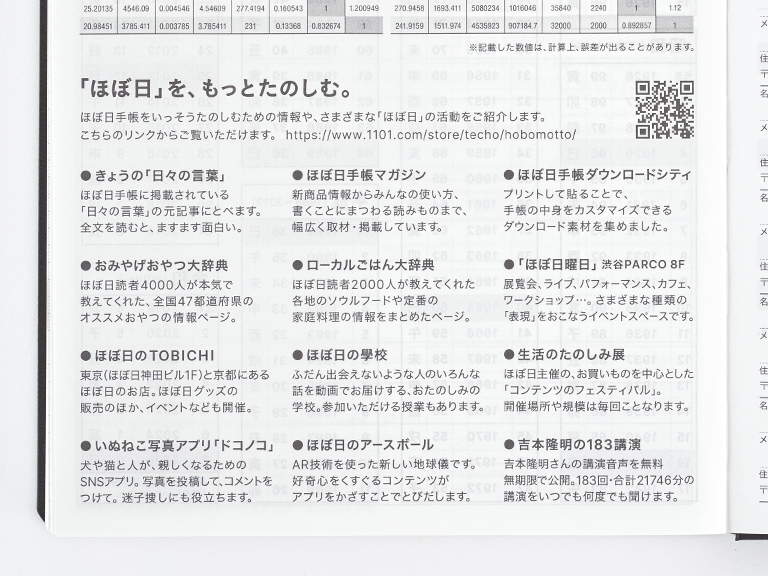
Getting the most of Hobonichi (Japanese)
This page includes information to further enjoy your Hobonichi Techo and an introduction to what Hobonichi does. Also contains a link to a list of Japanese articles the quotes are selected from.
About the English edition Original book:
The English edition is titled “Getting the Most Out of Your Hobonichi Techo” where you can discover all kinds of ways to have fun with your techo.
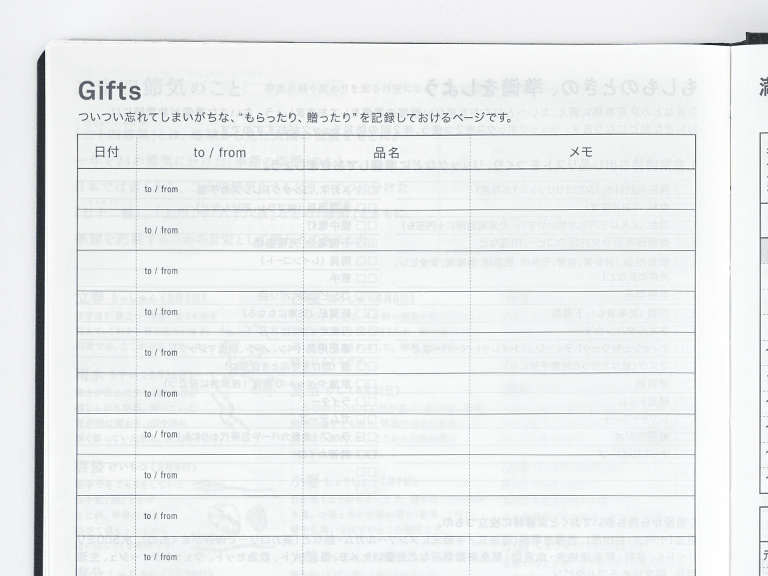
Gifts
Record the presents you’ve given or received in the Gifts page so you don’t forget who gave what to who and when. This is also helpful for thank-you cards.

Age Table (Japanese)
This table lists the year people were born, and their age in 2025 at a quick glance. The number to the left of the year is the corresponding year based on the traditional Japanese Imperial Era calendar, and to the right of their age is the character for the Chinese Zodiac. Highlighted years have the same Chinese Zodiac as 2025 (Year of the Snake).
About the English edition HON:
The English edition does not include this bonus page.
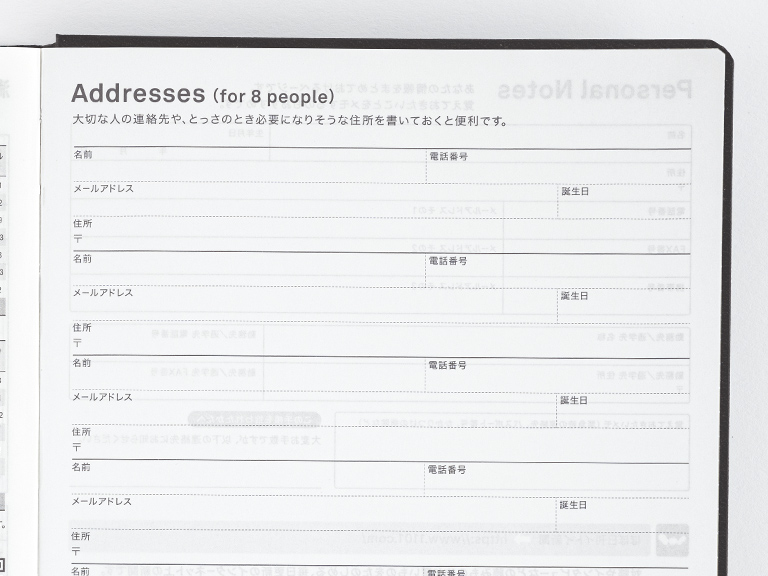
Addresses
The address book allows you to write in the contact information for your family and close friends.
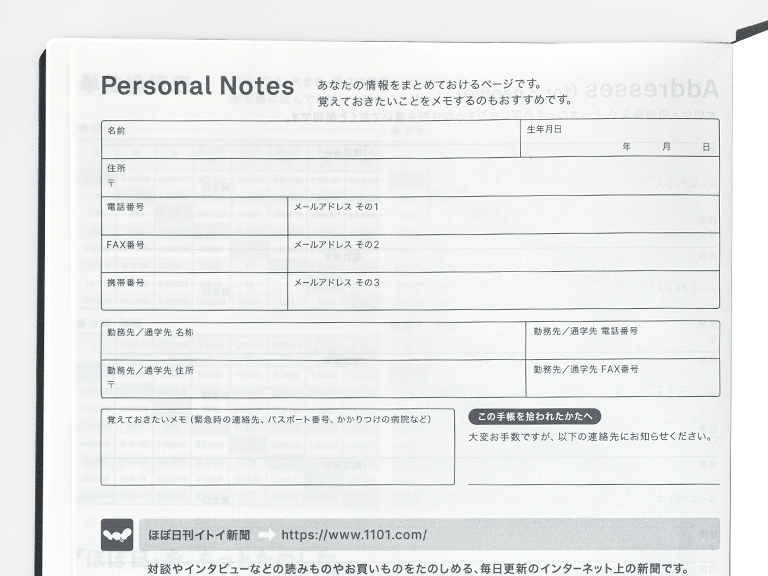
Personal Notes
Be sure to enter your contact information on the Personal Notes page in the back of your planner in case it’s misplaced.

